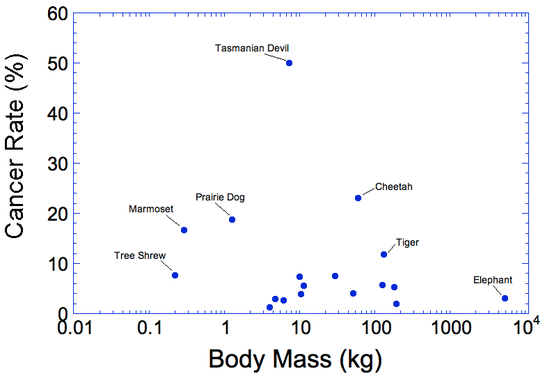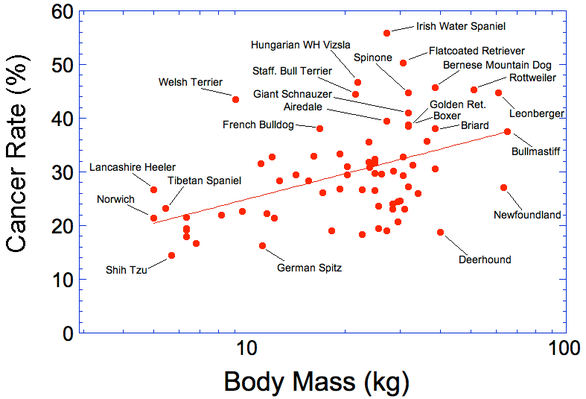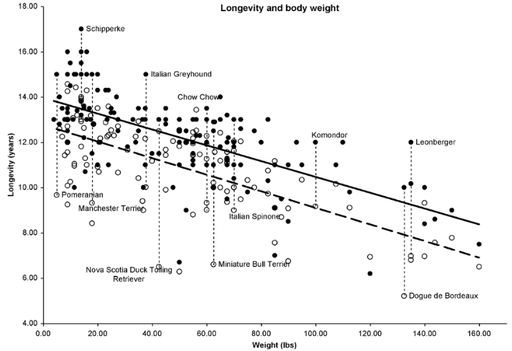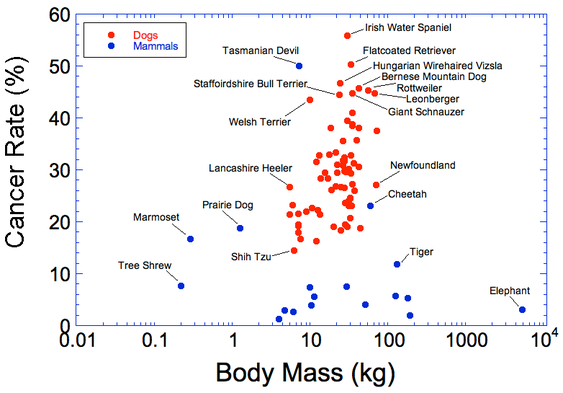There has been a paradox stewing for decades in the scientific literature about why large animals that have more cells and live longer don't also have an increased risk of cancer. The logic says that every time a cell divides, there is opportunity for a mutation to occur; so in larger animals that have more cells and also live longer, we should expect to see higher rates of cancer. But this is Peto's Paradox: rates of cancer don't seem to vary with body size at all, and in fact the cancer rate is especially low in the world's largest land mammal, the elephant (Peto et al 1975). How can this be?
Scientists wondering why elephants have exceptionally low rates of cancer started poking around in the elephant genome. What they found is that the elephants have stockpiled extra copies of the p53 gene. Whereas humans have only one pair of p53 genes, elephants have 20 pairs. In effect, the extra copies of p53 make elephants resistant to cancer.
Both papers are fascinating and explain this in much more detail, and I've provided links to the free downloads at the end so you can read more about this yourself.
But as fun as the elephant story is, though, what I was really excited to see was a table (in the supplementary materials of the paper by Abegglen et al) with data for rates of cancer for a variety of mammal species. I wanted to have a look at those data myself, so I got them into an Excel spreadsheet and made a graph.
Sure enough, as you can see in the graph below, over a range in size from mice to elephants, there is no evidence that cancer rates are higher in larger animals. There is a noteworthy outlier on this graph. The Tasmanian Devil is native to the Australian island of Tasmania, and the interesting thing about them is that they are being devastated by an infectious cancer that produces grotesque facial tumors and eventually results in death. Apparently it is spread when the animals nip or bite each other and transfer some of the cancerous cells. The immune system should kill these cells but it fails to recognize them a cancerous. In essence, the cancer cells are invisible to the immune system. So rates of cancer in the Tasmanian Devil are off the charts because of this extraordinary transmittable cancer.
The reason cancer was expected to increase with body mass is because large animals live longer, and more cell divisions over a lifespan provides more opportunities to produce a cell that becomes cancerous. But dogs don't fit the lifespan rule either; larger dogs have shorter livespans, not longer. But could the shorter lifespans of larger dogs be a consequence of their higher cancer rates? We would need to know why the large dogs are dying - is it cancer, or some other trait associated with larger body size that limits lifespan? Unfortunately, we can't answer these questions with the data at hand. But we can address the question we started with: Do dogs have more cancer than other mammals?
This is not a happy picture, and it answers the question very clearly. Yes, rates of cancer in dogs are higher- spectacularly so, in fact - compared to those for mammals in general. Cancer rates in other mammals are largely less than 20%, while in dogs there are only a handful of breedsin that range, and there are none at all lower than about 15%, where most of the mammals are. In fact, the Tasmanian Devil with its contagious cancer is matched by the Flatcoated Retriever and even outdone by the Irish Water Spaniel, with a half dozen more breeds almost as high.
Quite a bit of money is being spent on canine cancer research. Most of these studies focus on exploring possibilities for earlier detection and better treatment, both of which could do much to improve the lives and lifespans of dogs diagnosed with cancer, and they usually focus on one or a few specific breeds in which cancer rates are (perceived to be) high. But these data for dogs, especially in the context of information for mammals in general, suggest that there is a systematic problem here that is related somehow to body size: larger dogs have more cancer. Not only is there a stark difference in rates of cancer of dogs compared to other mammals of the same size, but there is also a clear difference between small and large dogs. Why? Maybe it has something to do with growth hormones (I have mentioned this here). Perhaps this is the manifestation of Peto's Paradox. We don't know because as far as I know, nobody is addressing the problem of cancer from a broad perspective that recognizes these patterns in the data.
A few clever scientists, knowing a bit about cancer in other mammals, have discovered a really interesting thing about the genomes of elephants that makes them especially resistant to cancer, something that tells us a bit more about the biology of cancer in all animals. I think dogs have much to tell us about this awful disease if we back away from addressing it as a breed problem resulting from genetic bad luck, and instead see it as evidence that there might be some unknown but fundamental process that is driving the risk of cancer in dogs. We just need to figure out what it is.
Peto R, FJ Roe, PN Lee, L Levy, J Clack. 1975. Cancer and ageing in mice and men. Br. J. Cancer 32: 411-426.
Sulak M, L Fong, K Mika, and others. MS. TP53 copy number expansion correlates with the evolution of increased body size and an enhanced DNA damage response in elephants. BioRxiv (doi: http://dx.doi.org/10.1101/028522). (pdf)
To learn more about the genetics of dogs, check out
ICB's online courses
***************************************
Visit our Facebook Groups
ICB Institute of Canine Biology
...the latest canine news and research
ICB Breeding for the Future
...the science of animal breeding





